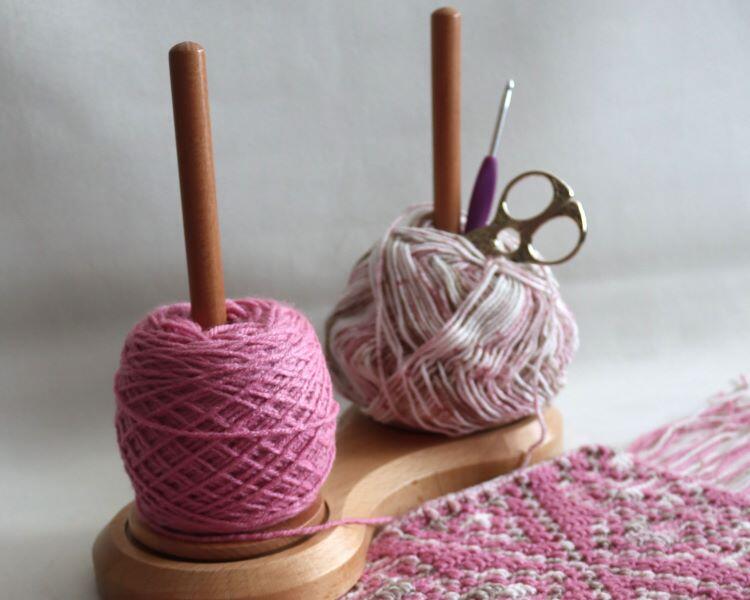In the enchanting world of knitting and crocheting, a yarn holder isn’t just a tool; it’s a companion that weaves through the journey of creating warm, heartfelt projects. From the simple yet functional bowl to the intricately designed yarn butler, yarn holders are as diverse as the projects they help create. This article delves into the various types of yarn holders, their purpose, and the qualities that make them indispensable to crafters. Yarn holders are also one of the best gifts for crocheters: 9 Best Gifts for Crocheters: A Thoughtful Guide.

Purpose of Yarn Holder
The primary purpose of a yarn holder (or yarn ball holder) is to manage yarn balls, preventing them from rolling away, tangling, or picking up dirt. It’s about creating an organized, efficient, and pleasurable crafting experience. For those who knit or crochet, a yarn holder is more than just a tool; it’s a facilitator of creativity, ensuring smooth, uninterrupted workflow.
Types of Yarn Holders
Understanding pros and cons of different types of Yarn Holders helps crafters choose the right type for their specific needs. This section will provide a detailed look at different yarn holder types, their advantages and disadvantages, and examples of each.
Yarn Bowls
- Pros: Prevents yarn from rolling away; the slot or swirl design allows for easy yarn guidance.
- Cons: Can be heavy and not portable; risk of breakage, especially with ceramic bowls.
Examples:
- Ceramic: ‘Ceramic Yarn Bowl‘ by Nagina International.
- Wooden: ‘Acacia Wood Yarn Bowl Holder‘ by Samhita.
Yarn Bags
- Pros: Highly portable; often have compartments for needles and accessories.
- Cons: Yarn can become tangled inside if not properly organized.
Examples:
- Backpack: ‘Knitting Bag Backpack‘ by Coopay.
- Rolling Yarn Tote: ‘Deluxe Yarn Storage Tote‘ by Everything Mary.
Yarn Butlers
- Pros: Provides a smooth yarn feed; prevents tangling and twisting.
- Cons: Less portable and more suited for stationary use.
Examples:
- Wooden: ‘Wooden Yarn Winder Butler‘ by Scheepjes.
- Metal / Plastic: ‘Wool Jeanie – Magnetic Wool Spindle‘ by D&S Components
Yarn Spindles
- Pros: Allows yarn to spin freely, preventing tangles; can handle varying sizes of yarn skeins.
- Cons: Typically for single skein use and not as stable as bowls.
Examples:
- Vertical Spindle: ‘Wood Yarn Holder Dispenser‘ by Two Stones,
- Horizontal Spindle: ‘Yarn Holder – 5 Skein Holder – Yarn Rack‘ by TheHatRackGuy.
Qualities of yarn ball holder to look for
When choosing a yarn holder, consider the following qualities:
- Material: The choice of material can greatly affect your crafting experience. Wood and ceramic add a touch of elegance but can be heavy, while plastic is lightweight and more portable.
- Size and Capacity: Consider the size of yarn balls you typically use. Some holders are designed for larger skeins, while others are perfect for smaller balls.
- Portability: If you’re a crafter who likes to take your projects on the go, look for yarn bags or portable bowls that are lightweight and durable.
- Stability: A good yarn holder should have a stable base to prevent it from tipping over.
- Aesthetics: Since it’s a part of your crafting space, choose a design that sparks joy and inspires your creativity.
A word about materials
Ceramic
- Features: Ceramic yarn holders are known for their weight and stability. They usually come with a glossy finish and can feature intricate designs and colors.
- Advantages: They are aesthetically pleasing and heavy enough to stay in place while you work. The smooth surface allows for easy yarn flow.
- Considerations: Ceramic can be fragile and may break if dropped. It’s best suited for stationary crafting spaces.
Wood
- Features: Wooden yarn holders are popular for their natural aesthetic and come in various finishes, from polished to rustic.
- Advantages: They offer a classic look and are generally very durable. The smoothness of polished wood ensures the yarn doesn’t snag.
- Considerations: Quality and finish can vary, and some woods may be prone to splintering over time. They are not as heavy as ceramic, but still provide sufficient stability.
Plastic
- Features: Plastic yarn holders are lightweight and often more affordable. They also come in a range of colors and designs.
- Advantages: They are highly portable and less prone to breakage, making them ideal for crafters on the go.
- Considerations: They may not have the same aesthetic appeal as ceramic or wood and can be less stable due to their lighter weight.
Metal
- Features: Metal yarn holders, often made from aluminum or steel, are durable and can have a sleek, modern look.
- Advantages: They are sturdy and long-lasting, with a weight that holds them in place during use.
- Considerations: Metal holders can be heavier, making them less portable. They also tend to be on the higher end in terms of price.
Fabric
- Features: Fabric yarn bags are soft, flexible, and often feature multiple compartments for organization.
- Advantages: They are extremely portable, lightweight, and can be folded away when not in use.
- Considerations: Fabric bags may not offer as much protection for the yarn against elements like dust or moisture and require regular cleaning.
Silicone
- Features: Silicone yarn holders are a newer addition, known for their flexibility and grip.
- Advantages: They are lightweight, durable, and can adapt to different sizes of yarn balls. Silicone also provides a non-slip surface.
- Considerations: They might not have the aesthetic appeal of wood or ceramic and can attract dust.
Conclusion
Yarn holders are not just tools; they are an extension of the crafter’s personality and creativity. Whether you prefer the classic elegance of a wooden bowl or the practicality of a portable bag, there’s a yarn holder to suit every style and need. In choosing the right one, you’re not just picking a container for your yarn, but selecting a companion for your creative journey.